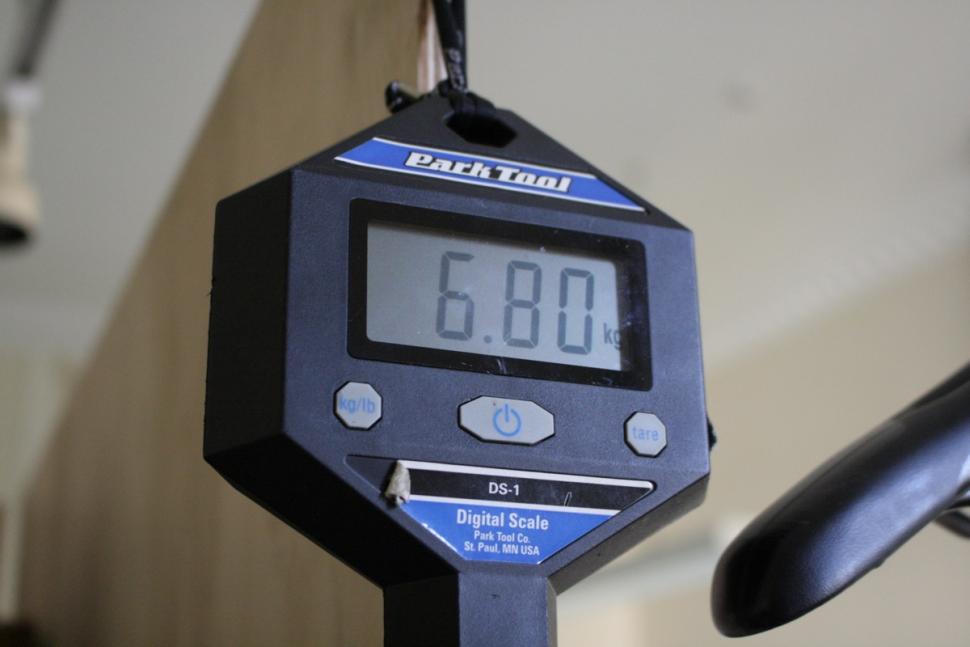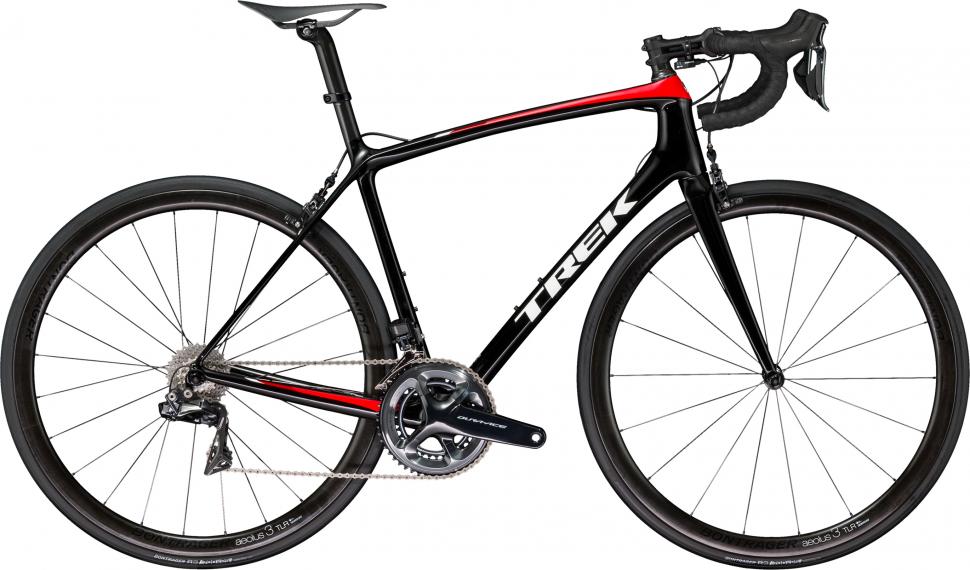- News
- Reviews
- Bikes
- Components
- Bar tape & grips
- Bottom brackets
- Brake & gear cables
- Brake & STI levers
- Brake pads & spares
- Brakes
- Cassettes & freewheels
- Chains
- Chainsets & chainrings
- Derailleurs - front
- Derailleurs - rear
- Forks
- Gear levers & shifters
- Groupsets
- Handlebars & extensions
- Headsets
- Hubs
- Inner tubes
- Pedals
- Quick releases & skewers
- Saddles
- Seatposts
- Stems
- Wheels
- Tyres
- Tubeless valves
- Accessories
- Accessories - misc
- Computer mounts
- Bags
- Bar ends
- Bike bags & cases
- Bottle cages
- Bottles
- Cameras
- Car racks
- Child seats
- Computers
- Glasses
- GPS units
- Helmets
- Lights - front
- Lights - rear
- Lights - sets
- Locks
- Mirrors
- Mudguards
- Racks
- Pumps & CO2 inflators
- Puncture kits
- Reflectives
- Smart watches
- Stands and racks
- Trailers
- Clothing
- Health, fitness and nutrition
- Tools and workshop
- Miscellaneous
- Buyers Guides
- Features
- Forum
- Recommends
- Podcast
TECH NEWS
 6.8kg scales 2 - 1.jpg
6.8kg scales 2 - 1.jpg74% of road.cc readers say the UCI's 6.8kg weight limit should be lowered or scrapped entirely
Is the UCI 6.8kg weight limit outdated? In a quick poll last week 74% of road.cc readers reckon the UCI should lower or scrap entirely the current 6.8kg weight limit.
We recently reported on the rumour that the UCI could be set to change the current 6.8kg bike weight limit that has been in place since the year 2000, intended to ensure bikes are safe to be raced at the highest level.
With 46.98% of the votes cast, support was biggest for the weight limit being lowered. Those calling for it to be scrapped entirely amounted to 26.98% of the votes, while 26.03% say it should be kept in place as it is.
A total of 315 votes were cast, not entirely the biggest selection admittedly but does provide an interesting analysis of reader opinion regarding the current weight limit.
So if the UCI is reading this, the road.cc readers have spoken, you should lower the weight limit. But how low should it go? That’s another can of worms entirely.
“I’d love to see it lowered to 4kg,” said Paul4f in response to the poll. “At the moment small riders are forced to ride bikes that weigh the same as larger riders which is unfair, smaller riders should be able to ride lighter bikes to make up for being a little less powerful. Also, it will allow a proper difference between aero and lightweight bikes again which might drive forward innovation.”
- How to trim bike weight on the cheap — save a kilo without breaking the bank
Could the manufacturers meet a lower weight limit with their current bikes? Some could; Trek's most expensive Emonda SLR 9 comes in at 5.88kg thanks to a 690g frame and a high-end build but a noticeable absence of really exotic carbon components. It does cost £8,500 mind...
Canyon once showed off the Canyon Ultimate CF EVO 10.0 Ltd. Costing a cool £11,799, it weighed a claimed 4.85kg thanks to a 665g frame and a 290g fork, Lightweight Obermayer wheels, THM Fibula brake calipers and Clavicula SE chainset, a Tune saddle and a SRAM Red 22 groupset. In other words, not your everyday components.
Do you agree with the poll results?
David worked on the road.cc tech team from 2012-2020. Previously he was editor of Bikemagic.com and before that staff writer at RCUK. He's a seasoned cyclist of all disciplines, from road to mountain biking, touring to cyclo-cross, he only wishes he had time to ride them all. He's mildly competitive, though he'll never admit it, and is a frequent road racer but is too lazy to do really well. He currently resides in the Cotswolds, and you can now find him over on his own YouTube channel David Arthur - Just Ride Bikes.
Latest Comments
- chrisonabike 7 min 16 sec ago
Sounds counterintuitive but I think fixing the legal system would be harder than fixing the street design and rules - and might even cost more!...
- brooksby 2 hours 3 min ago
It raises the question of why (or whether) the driver was even trying to park there; but for me, the scariest comment is by the taxi driver who...
- aramaerospace 3 hours 48 min ago
Increased drive friction and power loss:...
- Geoff H 5 hours 55 min ago
I was really enjoying the article until I came to the price!
- OldRidgeback 6 hours 48 min ago
I have a very old MTB (guess what make) that I'll happily leave locked at the train station or shops or whatever. The fairly new Trek MTB or...
- TheBillder 8 hours 23 min ago
Dualling that stretch of the A7 will allow hard-pressed motorists to travel very slightly faster between the rock that is the Sherriffhall...
- jaymack 11 hours 20 min ago
We must be related!
- The_Ewan 12 hours 49 min ago
But why worry if a few people do? It's just not a big deal....
- Tom_77 13 hours 53 min ago
Tempted to get him a sweary birthday cake like in The Thick Of It....
- Bigtwin 14 hours 22 min ago
Didn't happen did it? They came into my shop a couple of years back and said it was "on the way", but never heard anything more.

Add new comment
13 comments
“I’d love to see it lowered to 4kg,” said Paul4f in response to the poll. “At the moment small riders are forced to ride bikes that weigh the same as larger riders which is unfair, smaller riders should be able to ride lighter bikes to make up for being a little less powerful.
Maybe Paul4f should read up on power to weight ratios and realise that sometimes lighter riders even on heavier bikes still have the advantage.
Wasn't there a pro team riding a Cannondale with brass weights stuck to the top tube to bring it upto weight 5 years ago?
Been a few bikes that have been seen with this. Id happily see the rule lifted. And if it were, It would see an end to disc brakes. If you want a mega light bike its rim brakes all the way. Any climber will happily sacrifice stopping power over a bike thats 1-2 kg lighter.
Who cares what the UCI do. If you don't want to officially race, then you can build whatever weight bike you want, just like we could buy disc braked road bikes long before they could be used in a race.
Its only relevant in mountain stages anyway, and all the teams would invest in light bikes, so any advantage would be neutralised. Given that even mountain stages contain a good deal of fast flatter work and downhill, aero would probably give a greater advantage.
I'd personally rather the UCI did away with the constraints on bike dimensions, in order to allow manufacturers to really push the design envelope.
The UCI surely has a number of bigger fish to fry. Changing the weight limit won't help the sport or make it more interesting.
Pro races are the main way for manufacturers to persuade punters to part with silly amounts of money for bikes and parts regardless of the items' effectiveness. They are the only ones that would benefit from a change in the limit.
The crap talked about disc brakes being heavy and that small, light riders are disadvanted is just people putting their own spin on it. If you're that bothered about weight then eat less and train smarter.
I disc braked bike will always weigh morre than a rim braked bike though. Even if you used the lightest most space age disc components, you can do so with rim brakes which have far fewer components and no hydraulics which weigh more no matter what you make them of so an elite climber will always pick the mega light rim braked bike every time.
Total weight, you're probably right at the moment, although it's not to do with the hydraulics per se (e.g. hydraulic lines are typically lighter than cabling and the lightest mainstream disc groupset is fully hydraulic). As for whether it matters if the limit is lowered, i'm not so sure - as the total goes down we're getting into the realms of diminishing returns and aero is going to probably dominate it , especially on long descents.
Hydraulics require fluid and a reservoir for said fluid. As for the aero bit, climbers spend most of their time either sat in the peloton where aero is negated by the fact they are drafting in the bunch and climbing at speeds that dont take advantage of aero
Yep, the line weight saving includes the fluid and the resevoir may add to the total weight or not (e.g. in the case of the Rotor).
My main point however, was that hydraulics in and of themselves do not automatically add to the weight and may actually decrease it,
Have you asked them?
And even if they do choose rim brakes does it matter to anyone else? Do people choose their tyres, saddle or handlebar tape based on what a pro rider uses? Do you eat the same diet and do the same training? Have a following car with spares, clothing and bottles?
A 1kg reduction saves ca. 2 seconds per 100m of vertical ascent so even over a ride with 2,000m of ascent you only gain 20 seconds. TBH unless you're racing hill climbs or very steep/mountainous gran fondos then making a fuss about weight is merely an indulgence.
My understanding is that the rule came in to control costs. Whether or not that is still an issue, surely the question is really whether a light bike is fit for purpose. If you have no limit then some manufacturers are going to push the envelope, perhaps at the risk of rider safety. Perhaps the UCI could devise strength tests for frames, wheels and other critical components, and use these instead.
it's simple to build a UCI-approved frame into a bike, with stock components, that's miles under the 6.8kg weight limit. The Trek in the article is a perfect example: a full shimano groupset and bontrager wheels and finishing kit. it's expensive gear, but it's all stock stuff. That bike's almost a kilo lighter than the weight limit.
The UCI have been talking about certifying components but i think manpower is the issue. The approved frames list is a few pages; how many wheels/handlebars/stems/seatposts/saddles are out there? if they did, though, then the weight limit is redundant.
Shouldn't be too much of an issue really, there is maybe 8 different groupsets used by teams and only 45 teams in Pro-Conti and World Tour to get their stuff approved. Most will be using sponsored stuff and those that aren't will normally be using a brand that sponsors another team (Froome riding a Spez Power). Taking into account most team have 3/4 frames on the list it couldn't be too bad surely?